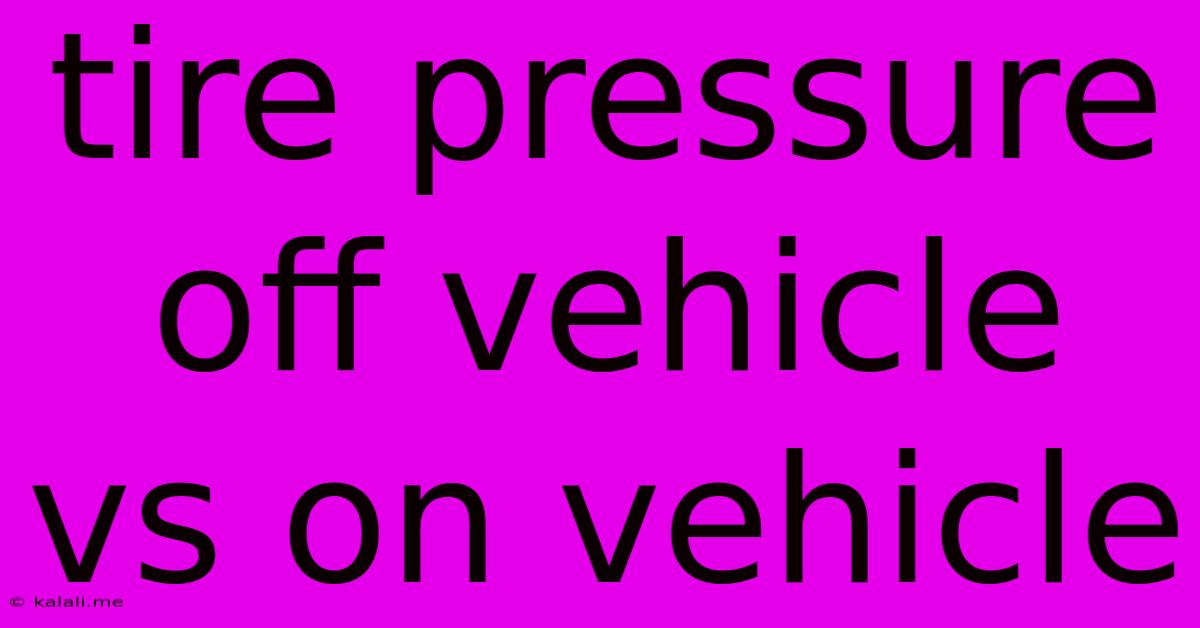Tire Pressure Off Vehicle Vs On Vehicle
Kalali
May 25, 2025 · 3 min read

Table of Contents
Tire Pressure: On-Vehicle vs. Off-Vehicle Readings – What's the Difference?
Maintaining the correct tire pressure is crucial for your safety, fuel efficiency, and tire longevity. But have you ever noticed a discrepancy between the tire pressure reading you get while your vehicle is parked versus when it's driving? This article clarifies the difference between on-vehicle and off-vehicle tire pressure readings and explains why this variation occurs. Understanding this difference will help you keep your tires properly inflated and ensure a safer, more efficient driving experience.
Why the Difference?
The primary reason for the discrepancy lies in tire temperature. When your vehicle is stationary, the tire pressure reflects the ambient air temperature. However, as you drive, friction between the tire and the road generates significant heat. This heat increases the air temperature inside the tire, causing the air molecules to move faster and expand. This expansion results in a higher pressure reading.
Think of it like a balloon: when you warm a balloon up, it expands. The same principle applies to your tires. The faster you drive and the longer you drive, the hotter your tires will become, and the higher the pressure will be.
On-Vehicle Tire Pressure: The Dynamic Reading
On-vehicle tire pressure readings, often obtained using a tire pressure monitoring system (TPMS), reflect this dynamic, higher pressure caused by heat build-up. These readings are a good indicator of your tire's pressure while driving. However, they are not the ideal measure to use when checking your tire pressure before you begin your journey.
Off-Vehicle Tire Pressure: The Static Reading
Off-vehicle tire pressure readings, taken using a gauge when your vehicle is parked and the tires are cool, provide a more accurate representation of your tire's actual pressure. This is the pressure you should use when referring to the recommended tire pressure listed in your vehicle's owner's manual or on the tire sidewall. Checking your tires when they are cold ensures a more consistent and accurate reading.
Which Reading Should You Trust?
While both readings are important, it's generally recommended to focus on the off-vehicle, cold tire pressure when inflating your tires. This is the benchmark against which you should compare your pressure readings. Using a reliable tire pressure gauge is essential for accurate measurements.
Practical Tips for Maintaining Proper Tire Pressure
- Check your tire pressure regularly: Aim for at least once a month, or before long trips.
- Check pressure when tires are cold: Ideally, check your tires before driving the vehicle or after it has been parked for at least three hours.
- Use a reliable tire pressure gauge: Accurate gauges are crucial for accurate readings. Regularly check your gauge's accuracy.
- Understand your vehicle's recommended tire pressure: This information is usually found in your owner's manual or on a sticker located inside the driver's side doorjamb.
- Consider your load: If you're carrying heavy cargo, you may need to adjust your tire pressure slightly upwards. Consult your owner's manual for guidance.
- Learn about your TPMS: Understand how your vehicle's TPMS works and what it indicates.
By understanding the difference between on-vehicle and off-vehicle tire pressure readings and following these tips, you can ensure your tires are properly inflated, contributing to a safer, more efficient, and more enjoyable driving experience. Maintaining correct tire pressure is a simple yet crucial aspect of vehicle maintenance that shouldn't be overlooked.
Latest Posts
Latest Posts
-
Can You Freeze Cream Cheese Frosting
May 25, 2025
-
How To Find Septic Tank Lid
May 25, 2025
-
How Can I Knock Someone Out
May 25, 2025
-
How To Add Nitrogen To Soil
May 25, 2025
-
Can I Cook Ground Beef From Frozen
May 25, 2025
Related Post
Thank you for visiting our website which covers about Tire Pressure Off Vehicle Vs On Vehicle . We hope the information provided has been useful to you. Feel free to contact us if you have any questions or need further assistance. See you next time and don't miss to bookmark.